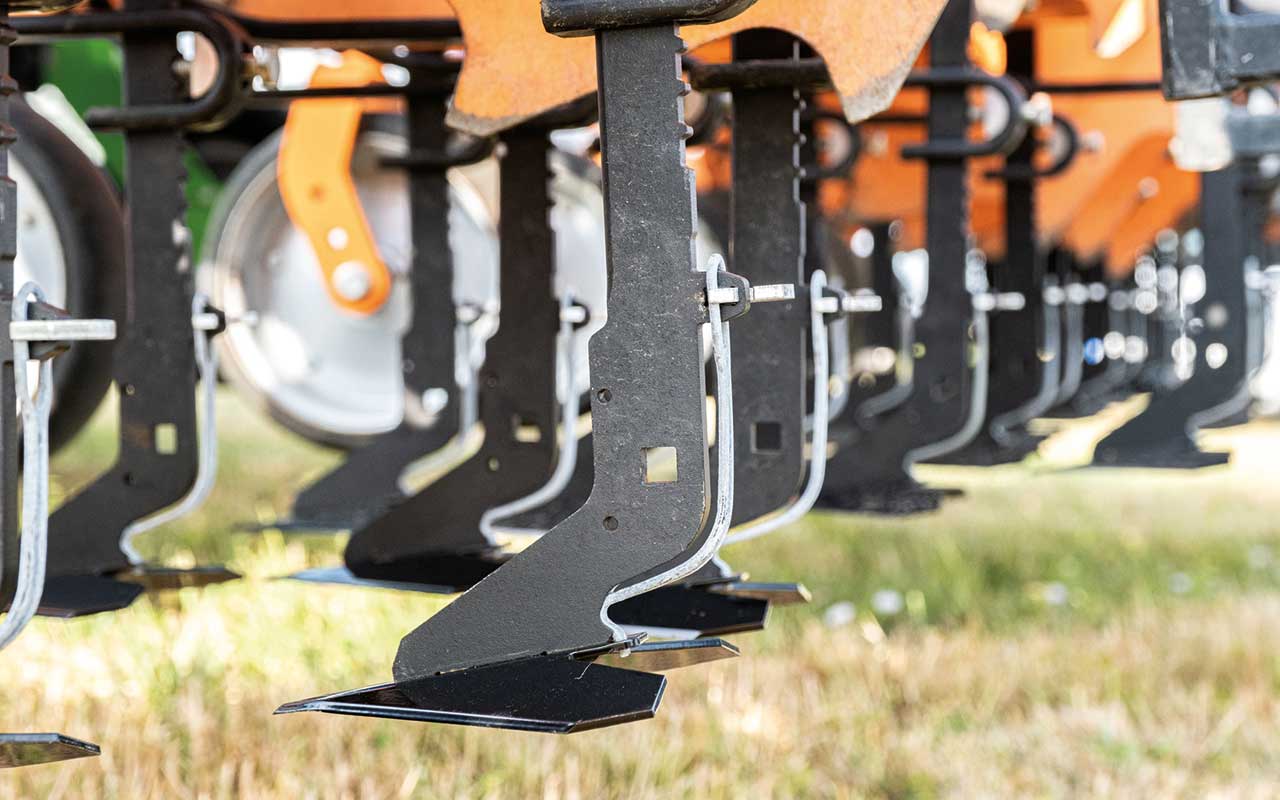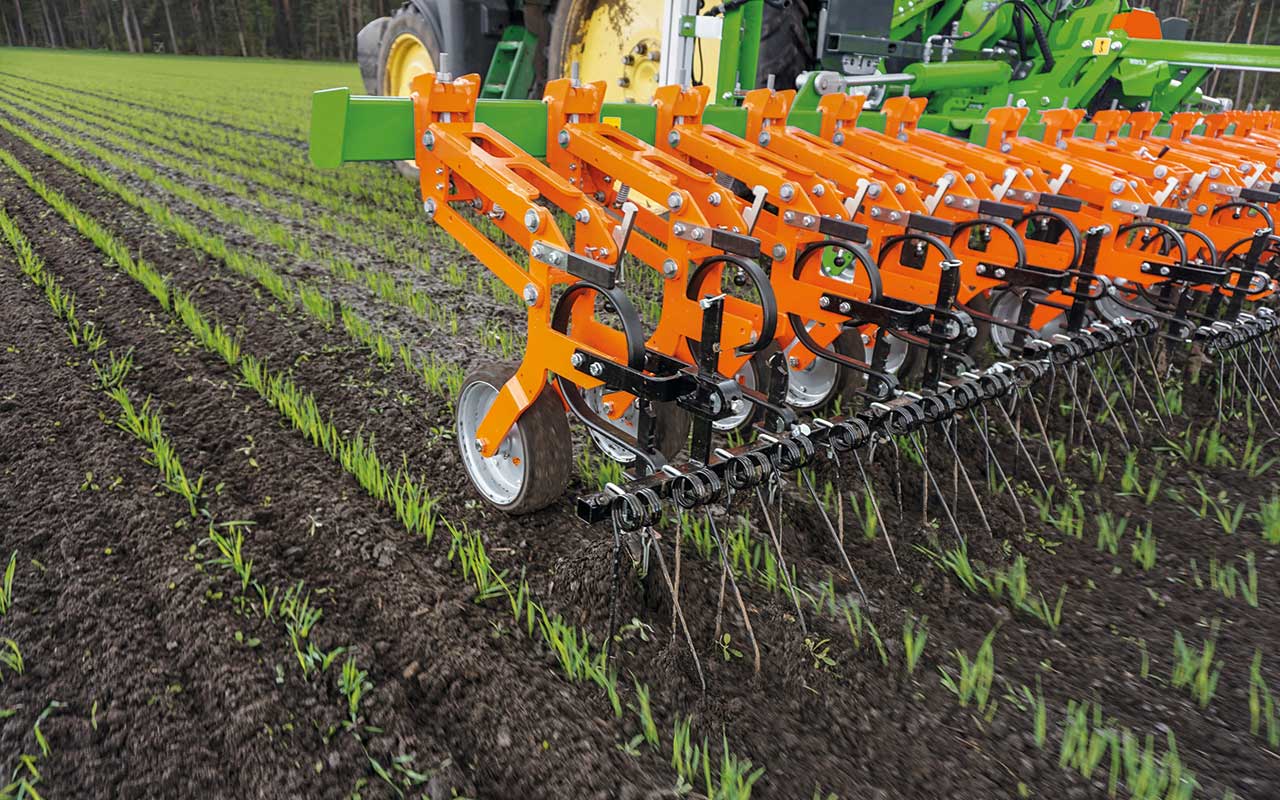In 2019, the German company Schmotzer was brought into the Amazone Group, adding a full range of mechanical weeding tools to Amazone’s cultivation, seeding, fertilising and spraying portfolio.
Initially, the Schmotzer brand retained its blue and orange livery and brand identity, as Amazone aimed to ease the transition for existing customers.
After six years, the companies are now fully integrated. New Schmotzer models feature Amazone’s familiar orange and green paintjob, as well as several design changes which the company claims will improve performance and make maintenance and operation easier for the customer.
Joel Robinson, product specialist, explains that the new design uses proven components from the Amazone range.
“We’ve built the new generation of hoes around the same frame design as our Precea precision drills, providing good commonality of parts and making it easier to match the hoes to our seeding technology.”
Working above the crop
The limitations around mechanical weeding often focus on the frame clearance, as weeds can continue to emerge until the canopy is closed. This is especially important in maize.
A variety of frame configurations are available across the Venterra series, affecting both the possible row widths and frame clearances.
They are all fitted with individual parallelograms to follow undulations in the field. The EKP is a narrow, single-blade set-up for 16cm row widths (although custom set-ups for 12.5cm-spaced cereals are available). This can be optioned with up to three blades to handle row widths up to 37.5cm in a single pass.
A second tension spring can also be fitted to maintain the correct ground pressure and working depth, regardless of conditions.
The multi-tool set-ups start with the KPP, designed for vegetable and energy crops with wider row spacings.
Each configuration includes five positions for tools, with a wide overlap between the hoeing blades to ensure a clean finish. These can be specified to either 45cm or 50cm, or a wide setting of 70cm.
Here we also see the larger frame clearance. The KPP-M increases the height to 80cm, while the KPP-L offers 100cm.
The KPP range also enables stepless depth control, allowing the amount of tillage to be adjusted based on weed growth and overall pressure.

Fully adjustable
As well as the working depth, Joel points out that every working component is adjustable through the Venterra range. “This starts with the choice of hoeing blades,” he says.
“Our shares use the patented RapidoClip system for toolless changeover, meaning that operators can quickly change worn shares, or swap over to different hoe widths to suit conditions.”
Duckfoot shares are available in widths from 80mm up to 380mm to maintain the desired overlap regardless of the row width.
These cut into the soil surface and work just below to destroy weed roots and bury the weed under the moved soil. They can be matched with offset blades at the edges, which minimise the soil movement near the crop rows to avoid burying the cash crop.
In stony conditions, spring tines can be fitted, although these are not available with the RapidoClip system. According to Amazone, they have the advantage of offering deeper working depths to help break up hardened or compacted soils, as well as providing some lateral movement to work around larger stones.
Chisel points are also available when working conditions are particularly hard, or when working in heavy soils. The narrow working width of the chisel point makes it suitable for crops that have a narrow spacing, such as cereals.
“We also have a wide variety of tools that work alongside, or behind, the main hoe,” Joel adds.
“Finger hoes are available to run alongside the crop row. These provide weeding action between the plants to limit competition within the row. As with the rest of the tools, these can be fully adjusted to tailor the aggressiveness.”
Ridging tools are available that cut a ridge into the soil and bury young weeds within the crop row. They need to be timed correctly, however, because if the crop is not advanced enough, it risks burying the crop as well.
To finalise the process, harrows can be mounted at the rear. As weeds are uprooted, the harrows drag them to the surface to dry out in the sun.
Another benefit is that if a seeding unit is mounted on the machine, it will incorporate any undersown crops, ensuring there is enough soil to promote germination.

Adding versatility
Efforts have been made to address one of the issues with mechanical weeding.
While growers recognise the importance of reducing their reliance on chemicals during crop care, it can be difficult to justify the additional capital expenditure and passes required in the field.
Amazone has focused development on increasing the number of operations that can be completed in one pass.
The RowSpread distributor head system can be linked to the FTender front tank to place granular fertiliser, seed or a combination of both in the rows.
This is useful for growers considering undersowing their maize with grass to minimise erosion and weed pressures, or those looking at cost-effective options for bi-cropping.
Nor has Amazone forgotten its spraying technology. Recognising that chemicals or biostimulants will continue to play a role in the foreseeable future, the company can fit its Venterra weeders with RowSpray band spraying equipment.
It says this can limit chemical applications by up to 85%, and in cases where herbicides are not being applied, growers can use the system to apply liquid fertiliser within the rooting zone.
The final piece of the puzzle in the Venterra system is Amazone’s new in-house-developed camera system.
The Smart Vision technology links to an in-cab display, and each camera can monitor up to five rows to avoid crop damage.
“This can work at speeds of up to 20kph, adjusting the sliding frame to stay within the row,” Joel concludes.
“It works faster than any grower would be able to and our artificial intelligence can detect weeds that are as small as 2x2cm.”



